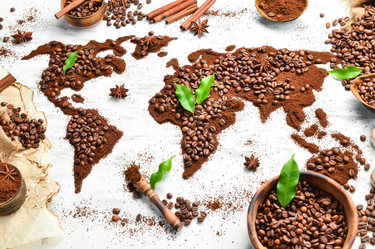History Of Arabica Coffee — From Ethiopia & Yemen To The World
The story of Arabica coffee begins in the highlands of Ethiopia and the mountain terraces of Yemen. Over centuries, this evergreen shrub traveled along trade routes and across oceans, shaping rituals, economies, and specialty coffee culture. This guide traces the origin story and global spread of Arabica, emphasizing moments that matter to modern roasters and café buyers in Malaysia.

Why Learn The History Of Arabica Coffee?
Understanding the history of Arabica coffee helps buyers predict flavor profiles, seasonality, and logistics. Origins weren’t chosen at random; they reflect centuries of selection for altitude, disease resistance, and taste. For Malaysian roasters, this background explains why Ethiopian washed coffees showcase jasmine and citrus, why Yemeni naturals lean toward dried fruit and spice, and why varieties like Typica and Bourbon seeded entire continents.
Scofi summarizes research from agronomy texts, trade histories, and field experience. We work with partners who steward heirloom forests, terrace farms, and modern estates—connecting their work to quality requirements of cafés from Kuala Lumpur to Johor Bahru.
A practical timeline of Arabica’s spread, a snapshot of key varieties, and pointers on how origin history influences taste, blending, pricing and delivery to Malaysia.
Origin Story: Ethiopia & Yemen
Arabica is native to the montane forests of southwestern Ethiopia where genetic diversity is deepest. Wild plants grew under canopy, and local communities used coffee as food, beverage, and social currency long before export markets. The famous goatherd tale is a folk memory of a longer truth: generations experimented with cherries, leaves, and roasted seeds.
Across the Red Sea, Yemen domesticated Arabica on terraced mountainsides. The port of Mocha shipped coffee to the wider Muslim world and Europe. Sun-drying practices—what specialty coffee now calls “natural processing”—concentrated fruit, cocoa, and spice notes. Water scarcity minimized washing; climate shaped process, process shaped flavor.
Forest to Terrace
Ethiopia represents coffee’s biodiverse “genetic bank,” while Yemen represents early selective cultivation and commercial trade. Together they set the processing styles and flavor archetypes still loved today.
Religious & Social Role
Coffee houses in the Islamic world offered sober gatherings for scholarship and music. Debates over permissibility often ended with acceptance as a stimulating, non-alcoholic drink.
Botanical Milestones
Key varieties dispersed—Typica and Bourbon—forming mother lines of much Arabica in the Americas and Asia-Pacific.
Arabica Coffee Spreads Across Continents
From the sixteenth century onward, trade networks carried Arabica far beyond the Red Sea. Political powers, botanical gardens, and missionary plantations all played roles. The result is a map of Arabica that mirrors maritime routes and colonial ambitions—but also local ingenuity. Farmers adapted coffee to new climates and pests, creating regional flavor signatures.
Asia’s story is diverse: Indonesia gained fame for old estates and aged “Monsooned” lots; India balanced washed Arabicas with robusta; Vietnam focused on robusta scale; while modern Malaysia imports specialty Arabica and experiments with highland plantings in select microclimates.
How Historical Pathways Shaped Varieties & Flavor
Because dispersal started from limited mother plants, many countries share genetic roots. Later breeding for yield and resilience produced region-specific families. For buyers, lineage clarifies what to expect in the cup and how to roast it.
| Lineage | Where It Spread | Typical Cup Traits |
|---|---|---|
| Typica | Caribbean → Central & South America; Asia | Clean, balanced, sweet; delicate acidity |
| Bourbon | Réunion → East Africa, the Americas | Rounded sweetness, red-fruit, cocoa |
| SL28/SL34 | Kenya & East Africa | Blackcurrant, citrus, high clarity |
| Heirloom (Ethiopia) | Local forests & smallholders | Floral, tea-like, bergamot, stone fruit |
See also: Typica • Bourbon • SL28/SL34 • Varieties overview.
Cafés, Trade & Culture — Why History Still Matters
Coffeehouses became engines of urban life: Ottoman salons, Enlightenment cafés, and today’s third-wave spaces. Meanwhile, plantations tied to colonial economies left complex legacies. Modern specialty markets aim to reward quality and transparency, investing in farmer partnerships, standardized grading, and traceability. Malaysia’s café culture mirrors this shift—more pour-over bars, lighter roasts, and customer interest in stories behind the cup.
From Port To Port
Historic export ports—Mocha, Jakarta, Santos, Mombasa—still echo in trade flows. Understanding routes helps plan shipping windows and freshness strategies for Malaysian inventories.
Processing Traditions
Washed processing proliferated where water & infrastructure were present; naturals persisted in drier climates. Geography remains a reliable flavor compass.
Resilience & Adaptation
Leaf rust outbreaks drove breeding programs and farm redesign. Recognizing which varieties were adopted and why explains price differentials and risk profiles today.
Practical Takeaways For Malaysian Roasters
- Flavor forecasting: Ethiopia/Yemen heritage tends toward floral/fruit profiles; Typica/Bourbon lines yield balanced sweetness; Kenyan SLs lean high-acidity.
- Roast approach: Preserve aromatics for Ethiopian washed; give naturals extra time to smooth fruit; medium development for nut-chocolate Brazils used with milk.
- Menu design: Pair an aromatic single-origin filter with a chocolate-forward house espresso. Use processing expectations to brief baristas and customers.
- Buying calendar: East Africa Q1–Q2 arrivals; Central America Q2–Q3; Brazil Q4. Align contracts with Malaysia’s peak café seasons.
- Risk management: Variety and region shape disease/weather risk. Hedge with a balanced basket (washed Ethiopia, Brazil pulped-natural, a Central American washed, and a seasonal experimental lot).
Keep Exploring Arabica With Scofi
These guides connect history to today’s buying decisions.
Washed, natural, honey, experimental—why they emerged where they did.
Historical and botanical contrasts that affect flavor and price.
What history teaches us about market cycles.
Samples, approvals, logistics & documentation for Malaysia.
FAQ — History Of Arabica Coffee
Is Ethiopia or Yemen the true birthplace of Arabica?
What does “Mocha” really mean?
How did Arabica reach the Americas?
Why are Ethiopian coffees so floral?
What historical events shaped today’s varieties?
Why do ports like Mocha, Santos, or Mombasa still matter?
How did processing traditions evolve by region?
Does Malaysia grow Arabica?
Which varieties are safest for a balanced café menu?
How does history affect prices today?
Ready To Choose Lots With The Right Heritage & Flavor?
Tell us your flavor target, roast style, and budget. We’ll shortlist coffees whose history of Arabica aligns with your menu—then send samples and handle delivery across Malaysia.
